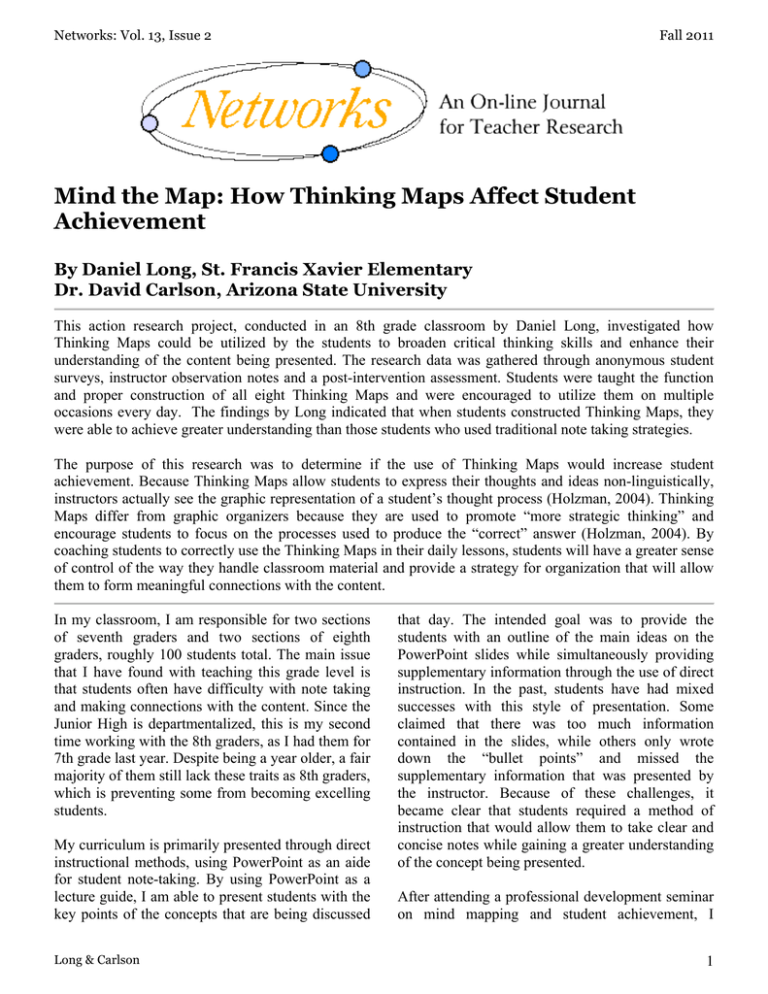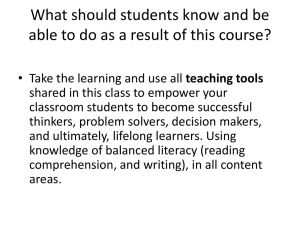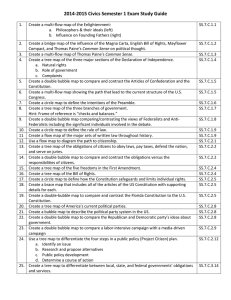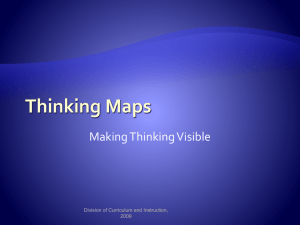Mind the Map: How Thinking Maps Affect Student Achievement
advertisement

Networks: Vol. 13, Issue 2 Fall 2011 Mind the Map: How Thinking Maps Affect Student Achievement By Daniel Long, St. Francis Xavier Elementary Dr. David Carlson, Arizona State University This action research project, conducted in an 8th grade classroom by Daniel Long, investigated how Thinking Maps could be utilized by the students to broaden critical thinking skills and enhance their understanding of the content being presented. The research data was gathered through anonymous student surveys, instructor observation notes and a post-intervention assessment. Students were taught the function and proper construction of all eight Thinking Maps and were encouraged to utilize them on multiple occasions every day. The findings by Long indicated that when students constructed Thinking Maps, they were able to achieve greater understanding than those students who used traditional note taking strategies. The purpose of this research was to determine if the use of Thinking Maps would increase student achievement. Because Thinking Maps allow students to express their thoughts and ideas non-linguistically, instructors actually see the graphic representation of a student’s thought process (Holzman, 2004). Thinking Maps differ from graphic organizers because they are used to promote “more strategic thinking” and encourage students to focus on the processes used to produce the “correct” answer (Holzman, 2004). By coaching students to correctly use the Thinking Maps in their daily lessons, students will have a greater sense of control of the way they handle classroom material and provide a strategy for organization that will allow them to form meaningful connections with the content. In my classroom, I am responsible for two sections of seventh graders and two sections of eighth graders, roughly 100 students total. The main issue that I have found with teaching this grade level is that students often have difficulty with note taking and making connections with the content. Since the Junior High is departmentalized, this is my second time working with the 8th graders, as I had them for 7th grade last year. Despite being a year older, a fair majority of them still lack these traits as 8th graders, which is preventing some from becoming excelling students. My curriculum is primarily presented through direct instructional methods, using PowerPoint as an aide for student note-taking. By using PowerPoint as a lecture guide, I am able to present students with the key points of the concepts that are being discussed Long & Carlson that day. The intended goal was to provide the students with an outline of the main ideas on the PowerPoint slides while simultaneously providing supplementary information through the use of direct instruction. In the past, students have had mixed successes with this style of presentation. Some claimed that there was too much information contained in the slides, while others only wrote down the “bullet points” and missed the supplementary information that was presented by the instructor. Because of these challenges, it became clear that students required a method of instruction that would allow them to take clear and concise notes while gaining a greater understanding of the concept being presented. After attending a professional development seminar on mind mapping and student achievement, I 1 Networks: Vol. 13, Issue 2 decided to introduce my classes to a note-taking concept called Thinking Maps, which allowed students to summarize information using visual techniques not commonly found in the outline format of my lecture notes. These graphic representations of thought allow students to abandon the outline format that they were accustomed to and demonstrate a more free-form expression of their learning using the eight different styles of map. For example, a Circle Map asks students to place the main idea in the center, and then add descriptions of the topic around it. A Double Bubble Map allows students to visually compare and contrast ideas using a series of bubbles connected to their topic. It is the goal of this research to determine whether the use of Thinking Maps will benefit students in their note taking abilities, thus increasing their level of achievement and understanding. Mind Mapping Thinking Maps In order for mind mapping to be successful, it is important that learners find a way to make the information relevant to their own lives. A great deal of research has indicated that the best way for learners to grasp a new concept is to construct a visual representation of it. Mind maps are a “useful tool for helping younger students with the process of building conceptual understanding of content and promoting achievement” (Mona & Khalick, 2008, p. 298). By using mind maps instead of traditional methods, students are able to visualize links between non-linear ideas, which in turn provides for creativity and meaningful learning. The use of color is often used to differentiate different ideas contained within the map, which “enhances the utility and meaningfulness to learners who construct them” (Mona & Khalick, 2008, p. 298). Because mind maps are essentially the visual representation of student thought, they allow for a greater retention of information. One of the most important aspects of the Thinking Maps is the ability for students to display critical thinking skills in order to complete their maps. In his study on the improvement of critical thinking skills, Carl Savich noted that the focus on “critical and independent thinking” were effective ways for teachers to maximize the engagement of the students in his class (Savich, 2009, p. 4). Long & Carlson Fall 2011 Specifically, Savich utilized role-playing and simulations to convey material to the students - a process which required all students to be engaged in a more critical manner of thinking. Savich concluded that his inquiry method of teaching allowed even the least confident students in his class to feel connected to the material, which in turn allowed them to see “the bigger picture” of history (Savich, 2009, p 4). In the same manner, Thinking Maps allow for students to feel more connected to the material, as it forces them to map out their thought process on paper, which leads to an increase in connections between content and experience. One of the initiators of the mind mapping was David Hyerle who maintained that brainstorming, organizers, and process maps were integral to “building conceptual links” in student understanding and recollection (Mona & Khalick, 2008, p. 299). When these three qualities are applied to mind mapping, they allow students to visualize their own thought process, in addition to making the construction of knowledge personal to them. Many of the maps developed by Hyerle were inspired by more conventional diagrams, such as the Venn diagram and timelines; however, Hyerle’s thinking maps were unique in the sense that they forced the students to construct new knowledge about a topic while simultaneously recalling what they already knew. Because these maps allowed students to construct their thoughts in different ways (kinesthetically, verbally, etc) they have been proven to “increase the retention ability among learners when the target information is visualized” (Mona & Khalick, 2008 p. 300). Additionally, it has been determined that if students are offered control over their map constructions, the maps have a positive impact on student achievement because they “embody metacognitive models with certain structures” (Mona & Khalick, 2008, p. 300). The study conducted by Mona and Khalick was guided by the following questions: what is the effect of using mind mapping on 8th grade students, does the impact of using mind mapping interact with prior achievement levels, and what is the relationship between different elements of participants’ mind maps. 2 Networks: Vol. 13, Issue 2 Thinking Maps Instruction In order to ensure that the students were using the thinking maps in the correct manner, all of the students were instructed using the same three step method: 1) direct instruction of each thinking map, 2) the instructor and students create a thinking map together, and, 3) the students create their own maps using an assigned topic. This three-step method gave students complete ownership of their map and allowed them to practice this new skill. Once they demonstrated the correct format for the different thinking maps, their goal was to determine how to best synthesize the information and create their own knowledge of the content using these maps. During the course of the intervention, all eight maps were taught to the students, but the main focus was on the Double Bubble, The Flow and The Multi-Flow maps (see Appendix A). The nature and practice of Social Studies lends itself to the constant use of these maps, as we made it a routine to compare and contrast ideas (Double Bubble), place events in proper time order (Flow Map), and determine the cause and effect of major world events (Multi-Flow Map). Direct Instruction Because each Thinking Map is designed for a specific purpose, it is imperative that students understand the correct manner in which to use it. If the students are able to recognize the correct use of each map, they will be prepared when asked to create on their own. Additionally, since each thinking map serves a different purpose, the students must be aware of the appropriate use of each. For example, a Bubble Map requires that students use only single adjectives to describe the topic, while a Circle Map allows for more complex thoughts and descriptions by allowing nouns, adjectives and even complete sentences to describe the given topic. Instructor and Student Once a Thinking Map had been demonstrated to the class, the students worked cooperatively with me to develop a new thinking map. This technique allowed for students to follow along step-by-step during the creation of the Thinking Map so that they would gain a greater understanding of its use. For example, if students were asked to compare and Long & Carlson Fall 2011 contrast two points of view, they would understand that the use of a Double Bubble Map would be the correct map choice. Independent Work Once the class had successfully crafted a map together, they created their individual maps. At the start of one class, students created a Double Bubble Map that compared and contrasted the Battle of Britain in 1940 to the invasion of France by the Nazi forces in 1939. Students were allowed to use their notes to help them complete all of the maps and were allowed to ask for assistance if they were having difficulty. This enabled me to assess whether students understood the correct function of each thinking map, and their understanding of instructional content. Methodology Prior to tracking the students involved in this study, all students were taught the correct format for using Thinking Maps, explaining each map and its intended purpose using the direct instruction method. After each map was introduced and practiced, students then engaged in surveys to determine their level of comfort with the maps, and their ability to construct the thinking maps in the correct context. During the course of the study, students were randomly assessed on their ability to take material they learned in the classroom and construct their responses in thinking map format. Their results were tracked over the course of the study and compared to their earlier creations in order to gauge their level of academic growth. Student Selection Four students were chosen for tracking in this study: one Hispanic male, one Caucasian male, one Hispanic female and one African-American female. All of these students have shown personal growth concerning their academics since they were in my 7th grade class, but are still lacking the ability to take clear and concise notes. As 8th graders, these students’ grades range from straight A’s to straight C’s across all of their classes. None of the students that were chosen has IEP’s to modify their instruction, and one of the four is enrolled in the district program for “gifted students”. Additionally, all four of these students participate in 3 Networks: Vol. 13, Issue 2 extracurricular activities, such as soccer, basketball, football and student government. Quantitative Methods During the course of the intervention, the students were consistently assessed on their understanding of the thinking maps by constructing one using an assigned prompt. At the end of the intervention, they were asked to construct a thinking map in lieu of writing a 5-paragraph essay. To analyze the students’ thinking maps, I noted not only the students’ correct use of the thinking map, but also whether the information they presented was accurate. Students were given a point if they correctly used the map, another point if the information used was correct, and a third if they contributed sufficient details to the map. Qualitative Methods The qualitative data consisted of my observations and pre/post intervention surveys. These methods were used to gather data as the intervention was taking place, allowing me to assess whether or not the students understood the thinking maps as they were creating them. Because of the instructional methods used (direction instruction, group instruction, and individual creation), I was able to walk around during class to visually observe the students work. Observational Notes. Observation notes were taken a minimum of three times a week during the intervention period, and were used to illustrate student development for each of the thinking maps. My notes consisted of short phrases or common words that could be used to identify positive or negative reactions to the maps. The results were based upon the students’ uses of the three thinking maps that were presented in class. Students were evaluated as to whether or not they appeared to understand the purposes and uses of the maps during the presentation, as well as their ability to complete thinking maps on their own. Observations were coded as either positive or negative. For example, while learning the Double Bubble Map, Student B attained positive results in “Understanding the Map” and “Using Sufficient Details,”, but was unable to provide a brief description of the thinking maps. On the final thinking maps assessment, all of the focal students Long & Carlson Fall 2011 performed well in regard to conveying correct information. One student continued to struggle with the specific uses for each of the thinking maps, which led to a lower overall score due to lack of details provided during the assessment. Surveys. Pre and post surveys were administered to the students. The pre-intervention survey was used to assess student motivation, while the postintervention survey allowed me to assess whether the thinking maps intervention was successful. In the first survey, I chose to highlight four of the questions related to Thinking Maps: 1. I learn more by taking notes and reading the textbook. 2. I expect to do well in school with little effort. 3. I am often bored in class. 4. My teacher challenges me to think critically about the topic being presented. The students used a Lickert Scale to rate their responses. These numbers were entered into an Excel spreadsheet so that I could look across the students’ responses. The post assessment focused on three questions that related to Thinking Maps activities: 1. The thinking maps are an effective way to get my thoughts on paper 2. The thinking maps allow me to make connections that I might not have made otherwise 3. The thinking maps have replaced my regular style of note taking Again using a Lickert Scale, students’ responses were scored and entered into an Excel spreadsheet. The surveys allowed me to determine whether individual students believed they were affected by the Thinking Maps intervention. For example, while on the pre-intervention survey students A, B, and D indicated that they learn better when they are taking notes from the textbook. The post-intervention data indicated that only Student B believed that thinking map strategies replaced their regular style of note taking in a consistent manner; the other three students only used thinking maps in moderation, or when required to do so. Findings The purpose of this project was to determine if the use of Thinking Maps would have an impact on the 4 Networks: Vol. 13, Issue 2 way 8th grade students at Magnet Traditional School compiled their notes and made connections to academic material. The biggest change for students using the Thinking Maps has been their ability to connect prior information to the content that is currently being studied. Because of the nature of Social Studies, each of the events covered in class is somehow related to either a prior world event or has its roots in a particular theoretical perspective. In order to fully understand the scope of what is being taught in class, it is important for students to constantly apply prior knowledge to new material. Therefore, I surmised that students would benefit from a method for linking new learning to past learning. In the post-survey results, all the students found the Thinking Maps allowed them to “get their thoughts onto paper”, thereby increasing their ability to make connections across the curriculum. While reviewing the assessment that required students to respond to a prompt via a Thinking Map, I noted that their answers reflected greater understandings of content than assignments that relied on short answer or essay formats. This did not surprise me, as many of the students had difficulty organizing their thoughts into coherent essays or crafting precise short answer responses. Many students simply restated their main points without providing significant supporting details. Thus, many of them received low grades when they were asked to write specifically about particular an events and issues. When asked to respond using a thinking map, students were generally able to provide relevant details and address the questions being asked. Using my observation journal, I noted that most of the students had initially shown difficulty understanding the Multi-Flow thinking map, which asks them to identify the cause and effects of specific historical events. By encouraging students to respond more often using this type of thinking map, they became more comfortable using this style of thinking map, and they became more proficient in predicting the outcome of historical events. Using the Multi-Flow maps, students were asked to predict the effects of the United States entering the Vietnam War based upon what they had previously learned with the conflicts in World War II and the Korean War. Long & Carlson Fall 2011 This action research project demonstrated that when these students used thinking maps on a regular basis, they were able to perform various thought processes invited by the type of map they were required to create. Once this became apparent to students, they recognized Thinking Maps as important to their academic success. Conclusion Based on my observations and the data collected, I expect that students who utilize thinking maps will see improvements in their academic progress with regards to higher order thinking and content connection. Thinking maps are beneficial to students and teachers because they illustrate how students link ideas and concepts. Unlike graphic organizers that generally involve only surface level facts, thinking maps invite students to demonstrate their thought process on paper instead of in their minds. By doing so, they provides students with opportunities to form insights related to academic content that might not have been activated prior to the students’ use of thinking maps. With the current focus on high stakes testing and meeting annual yearly progress, many school districts are focusing on preparing students for standardized tests and spending less time teaching students to think critically. Thinking Maps provide a method that will help students organize their thoughts and ideas when it comes to preparing for exams. As well, Thinking Maps help students to organize notes and information during lectures. Asking students to take notes using Thinking Maps invites them to apply their previous knowledge via a new medium, allowing for higher order thinking. In conclusion, Thinking Maps make an excellent addition to any classroom because they teach students to think critically about subjects and form connections between subject disciplines. By watching their thoughts unfold in front of them, they will be better equipped to make curricular connections and develop deeper knowledge and understanding of concepts. Since Thinking Maps can be utilized across all grade levels and content areas, they are an invaluable resource for teachers. With so many schools basing their curriculum and instruction on standardized tests, students are rarely afforded opportunities to develop critical thinking 5 Networks: Vol. 13, Issue 2 Fall 2011 skills that are necessary in higher education. I expect that with continued instruction and practice, classes that utilize thinking maps on a daily basis will show greater gains, both on classroom assignments and on standardized assessments. References Abi-El-Mona, Issam and Adb-El-Khalick, Fouad. (2008). The Influence of Mind Mapping on Eighth Graders’ Science Achievement. School Science and Mathematics, 180, 298312. Entwistle, N.J., Thompson, J. & Wilson, J.D. (1974). Motivation and Study Habits. Higher Education, 3, 379-96. Holzman, Stefanie. Thinking maps: Strategy-Based Learning for English Language Learners (and Others). Presented at the 13th Annual Administrator Conference, April 2004. Pintrich, P. (2003). A Motivational Science Perspective on the Role of Student Motivation in Learning and Teaching Contexts. Journal of Educational Psychology, 95, 667-686. Savich, Carl. (2009). Improving Critical Thinking Skills in History. Networks Online Journal, 11, 1-12. Schunk, D.H.(2008). Learning Theories, An Educational Perspective. New Jersey: Merrill Prentice Hall. Long & Carlson 6 Networks: Vol. 13, Issue 2 Fall 2011 Appendix A: Thinking Map References Double Bubble Template Flow Map Multi-Flow Map Long & Carlson 7





